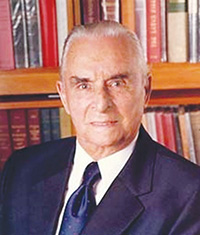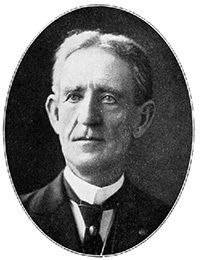From New Dawn Special Issue Vol 18 No 2 (Apr 2024)
One of the most remarkable spiritual teachers of modern times, Richard, Duc de Palatine (1916-1977), is little known today outside of a handful of modern Gnostic churches and initiatory orders.
His biography was capably summarised by Mehmet Sabeheddin in an earlier article in New Dawn, which was the first introduction many people have had to de Palatine’s work.1 The teachings he handed down are even less well-known than the man himself. Yet the spiritual path de Palatine taught in his public writings and the private lessons passed on to his students is as relevant now as it was in his own time. It shows a way past the corrupt hierarchies of politicised religion to a spirituality founded squarely on individual human freedom.
Many of those who knew de Palatine personally were profoundly impressed by the authority and the sense of “knowingness” that shaped his public presence even when he was a young man. His own writings confirm the impression of a man guided by inner certainties rooted in spiritual experience. Though his core insights were always his own, those insights were shaped in important ways by the esoteric traditions he studied and the initiatory lineages that were communicated to him. A brief survey of de Palatine’s own spiritual journey will therefore help set the stage for an outline of the teachings themselves.
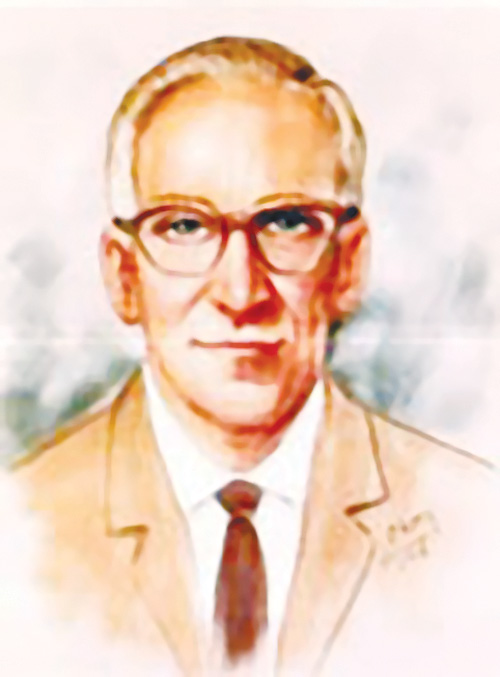
Richard, Duc De Palatine was born on 4 July 1916 as Roland (Ronald) John Powell in the Melbourne (Australia) suburb of North Fitzroy, the son of William John Powell and Annie Powell (Hancock). He studied at Melbourne University, serving with Australian military intelligence in WWII. He legally changed his name to Richard John Duc de Palatine after relocating to England from Australia in the late 1940s.
A Quest For The Light
His birth name was Ronald Powell, and he was born in Melbourne in 1916. From earliest childhood, he had a sense that some unseen power guided and protected him. Raised as a Christian, he dabbled briefly in rationalism, then entered the Catholic Church and attended Mass regularly for some years. By 1935, however, his disagreements with Catholic doctrine had become impossible to ignore, and he left the Church and began a period of spiritual seeking.
In 1938 he joined the Theosophical Society, then an influential presence in the alternative spirituality scene in Australia and elsewhere. Theosophical teachers Geoffrey Hodson and John A. Farquharson guided Powell through the Society’s teachings. At least as influential was the Melbourne Theosophical Lodge’s library, which included G.R.S. Mead’s groundbreaking translations of surviving Gnostic literature and a wealth of works on the Essenes and the ancient Mysteries – subjects that would be central to Powell’s teachings later in life. The evidence of his later writings shows that he studied books by all the important Theosophical authors as well as the works of two American Rosicrucian teachers, Max Heindel and George Winslow Plummer.
Probably by way of the Melbourne Theosophical library he also encountered the works of another extraordinary teacher, George Washington Carey. Born in 1845, Carey was an American mystic and healer whose work focused on the twelve biochemic tissue salts, a form of homeopathic medicine that uses the mineral salts found in the human body. Carey’s handbook of the tissue salts was for many years a standard text in this branch of alternative medicine. However, his interest in the tissue salts was not limited to their healing powers. Later in his life, he came to focus on one of the inner secrets of esoteric spirituality: the role played by hidden aspects of human biology in the quest for transcendence.
Carey’s work also drew on Christian tradition in a fascinating way. Having studied the work of many earlier writers, Carey came to understand that the Christian Gospels were not historical documents meant to be taken literally but skilfully crafted parables based on a deep understanding of the subtle anatomy of the human body. Through the myth of the birth, life, death, and resurrection of Jesus, they communicated a powerful system of personal spiritual transformation. Carey’s works, especially his last book God-Man: The Word Made Flesh, had a profound impact on Powell, who quoted Carey at length in his own writings and included material on the biochemic cell salts in his private lessons for students.
By 1948 Powell had become a teacher in his own right in the Melbourne area, with a circle of committed students. However, the “invisible presence” that guided him had other plans for him, and he travelled to London that year, settling in Kensington. Frequent visits to France brought him into contact with a wide range of European esoteric orders, and he received initiation into a series of potent spiritual lineages.
The sources of some of these lineages may raise hackles in today’s alternative culture, as they were preserved in European royal and aristocratic families. It needs to be remembered, however, that the old aristocracies of Europe were never monolithic. To borrow a metaphor from Dune, there were plenty of Harkonnens amid European nobility but there were also equivalents of the Atreides. Over the centuries, it was by and large the Harkonnen-equivalents that triumphed, but some of the others survived in relative obscurity.
It was from certain of these latter lineages that Powell received a series of initiations passed down for centuries from the Knights Templar and other initiatory bodies that preserved the ancient wisdom. In the course of these initiations, he was ennobled, taking the new name Richard Jean Chretien, Duc de Palatine. He was also consecrated as a bishop in 1953 by Mar Georgius (Hugh de Willmott Newman), Patriarch of Glastonbury, one of the most influential figures in the movement of free bishops, then evolving a sacramental Christianity independent of established religious hierarchies.
All these influences came together in 1953. Late in that year, Bishop Richard, Duc de Palatine founded the Pre-Nicene Gnosto-Catholic Church to restore the Gnosis of the Soul – the secret teachings of the Gnostics and their heirs – to the Christian Churches. He also received a charter from the Fratres Lucis (Brothers of Light), an esoteric order that traces its origins to the fifteenth century, authorising him to establish an initiatory order alongside the church. Thereafter he devoted his time to teaching and writing, publishing a monthly magazine and a series of booklets on the Gnosis of the Soul through his Pre-Nicene Publishing House, and writing and circulating correspondence lessons to students throughout the world. In 1971, he relocated to the United States and remained there, always busy, until his death in 1977.
The Gnosis of the Soul
In the course of his work, de Palatine wrote more than two dozen essays of various lengths, as well as two correspondence courses for his students. These still survive and are available to students of the Gnostic churches and initiatory lineages he set in motion. As with most of the old traditions of initiation, some aspects of the work are kept private by their current custodians, just as they were by de Palatine himself. The first steps in the teachings can be outlined readily enough.
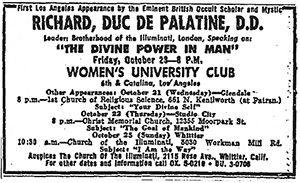
The first and in many ways the most crucial point about de Palatine’s teachings is that he never claimed that they were original. In his view, one Wisdom Religion has been passed on by enlightened saints and sages since human beings first incarnated on this planet. That tradition has never died, though it has been obscured in some ages by corrupt priesthoods and tyrannical governments, and it is endlessly renewed by emissaries from the inner realms of being – human souls who have passed beyond the need for incarnation but return to material existence to help their fellow humans find their way to the path of the spirit.
Central to the Wisdom Religion that de Palatine taught is a clear sense that God is not “out there” somewhere, an external presence exercising an arbitrary despotism over all things. “The Kingdom of God is within you,” said Jesus. Turn within and you will find that behind your personality, or Personal Soul, is the individuality or Higher Ego, the self that passes from life to life in the course of reincarnation. Behind the Higher Ego, in turn, is the Higher Self or Christos Body, an inseparable ray of the One Life which is God. Thus the spiritual quest always leads within, and seeks to awaken that inner knowing that brings the Personal Soul into harmony with the Higher Ego and the Higher Ego into harmony with the Higher Self.
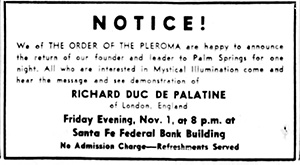
The Christos Body, in turn, is the Christ that matters in terms of personal salvation. In his book Christ or Jesus? de Palatine argued that the life of Christ in the four canonical Gospels is an invented narrative meant to communicate a path of spiritual transformation. It was based to some extent on the life of the Jewish spiritual teacher Jeshu ben Pandira, who lived and died around 100 BC. But the “Jesus Christ” of the canonical Gospels never actually existed as a living person, and the cult of Jesus as a historical person promulgated by the mainstream Christian churches is based on a cascade of misunderstandings circulated by early Christian teachers too literal-minded to grasp the profound metaphors of the Gospel myth.
The life of Christ, in de Palatine’s teachings, thus has to be understood not as the story of one divine person but as a guide to the transformation of each individual soul. Just as there are five traditional stages in the Gospel narrative, there are five stages along the path to complete enlightenment. We can examine them one at a time.
1. Birth. This is not the physical birth of the individual but the birth of the Christos, the radiant presence of divinity in the self, within the individual heart. This is the beginning of genuine spirituality, the replacement of outward forms with inward transformation. Inevitably the lower or animal self pushes back. Its instruments are the “images of menace,” parasitic forms created by unbalanced thoughts, feelings, and cravings, which reside in the subconscious and are stirred up by any effort at spiritual growth. These parasitic forms try to suppress the newborn spiritual potential of the individual; this is the real meaning of King Herod’s attempt to slaughter the infant Christ.
2. Baptism. In the myth of the Christos, the baptism of Jesus by John the Baptist was the beginning of Christ’s earthly ministry. In the Gnosis of the Soul, it is the awakening of the power to perceive the inner regions. Psychic potentials such as telepathy begin to manifest themselves, and these powers unfold step by step until the individual becomes a risen Son of God emerging from the sepulchre of his own material body.
3. Transfiguration. The narrative of Christ’s transfiguration is enacted by the individual seeker when the light of the higher self begins to illuminate the vestures or subtle bodies that surround it. In order to achieve this stage, the last vestiges of egoistic desire must be released. Once that has been accomplished, the individual becomes aware of his unity with the Supreme Soul, and he begins to function on the abstract planes of being where all things are perceived as one.
4. Crucifixion. The animal self has not yet been wholly defeated, however, and the final battle between it and the awakening soul remains to be fought. This is the equivalent, in the path of the individual, of the crucifixion in the mythic narrative of the Christos. This final struggle completes the soul’s earthly pilgrimage; after this, there is no need to reincarnate further in a body of flesh, for the soul has learned everything this planet can teach it.
5. Ascension. Having completed the journey set out symbolically in the Gospel narratives, the soul then ascends to become one with its own Divine Soul in those higher realms of being that traditional Christian mythology calls “heaven.” Having become an adept of the Gnosis and a member of the communion of saints, the fully awakened soul may then choose either to descend again to earth to help other souls complete the great journey or labour in other, subtler spheres of existence for the betterment of all.
Beginning the Path
The system of spiritual development passed on by the ancient Gnostic Christian churches, before they were driven into hiding by the political religion of Constantine and his successors, was called the Disciplina Arcani or the Arcane Discipline. This was the name de Palatine used for the system of training he passed on to his students.
In de Palatine’s vision, religion was always a way of life and not just a set of beliefs. Students of the Arcane Discipline are given a set of ideals to embody in their lives. The hard work necessary to enact these ideals develops the inner capacities needed to proceed on the path. What are these ideals? First and most essential, control of thought; next, purity of mind, emotions, and body; third, compassion toward all beings. As these three qualities become habitual, the aspirant begins to receive attention from his or her inner Teacher, the spiritual being who will supervise that person’s training. Much of this training will take the form of trials and tests in everyday life. According to the aspirant’s response to these trials and tests, new lessons will be forthcoming.
The ideals just listed are the most important capacities to develop in the early stages of the path, but certain others can also be pursued at the same time. The lessons de Palatine wrote for his students specify the ideals needed for the path as discrimination; indifference to worldly objects; control of the mind, the body, and the senses; tolerance; endurance; faith; equilibrium; and the desire for liberation. In addition, training in concentration and meditation also plays an important part in the practical work. One basic meditation from de Palatine’s writings is included here (see page 37). There are many others the aspiring student receives as the lessons proceed.
At present, the teachings passed on by Richard, Duc de Palatine are still preserved by a handful of small organisations, as noted earlier, and interested students must make an effort to find them. He liked to point out that truth ever reveals itself to the sincere seeker. The basic elements of training summarised here are suitable for beginners. Those who practice them and set out in quest of more light are unlikely to be left in darkness for long.
Recommended reading: “Meeting with a Magus: The Untold Story of Richard, Duc de Palatine & The Brotherhood and Order of the Pleroma” by Mehmet Sabeheddin in New Dawn Special Issue Vol. 13 No. 2, available as a digital download at www.newdawnmagazine.com/product/new-dawn-special-issue-vol-13-no-2.
Footnote
1. Mehmet Sabeheddin, “Meeting with a Magus: The Untold Story of Richard, Duc de Palatine & The Brotherhood and Order of the Pleroma,” New Dawn Special Issue Vol. 13 No. 2, 65-70.
© New Dawn Magazine and the respective author.
For our reproduction notice, click here.




